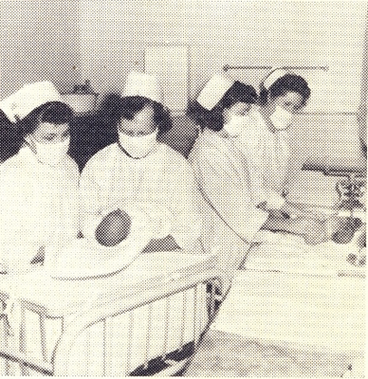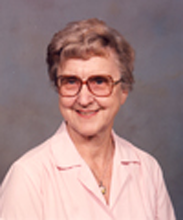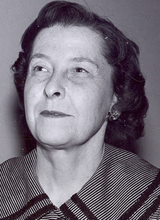Practical Nursing at the University of Minnesota
The idea for a practical nursing program actually began in 1939 when a professor in the School of Agriculture (J.O. Christianson) proposed home practical nursing courses in the school’s Home Management curriculum to assist rural physicians (Glass, 1983). The school was interested in providing a program for women to complement its programs for rural men (Taylor, 2015). Director Densford and Lucile Petry of the School of Nursing provided consultation despite the fact that they did not favor the idea. The School of Agriculture established its Practical Home Nursing curriculum in 1941.
Practical nurses had been introduced in the WWII era in response to a major national shortage of nurses. Many who worked as practical nurses in the 1940s had no preparation. In 1930 there were eleven schools for practical nursing and 25 more were added by 1947. But the number increased steadily after that so that between 1948 and 1954 another 260 schools emerged (Kalisch & Kalisch, 1995). Eugenia Taylor confirmed that a shortage of nurses in Minnesota was another impetus for the program at the University (Taylor, 2015).

Five years after the School of Agriculture established a Practical Home Nursing curriculum, the administrator of the university’s hospitals (Ray Amberg) and Dean Diehl of the College of Medical Sciences spoke with Ms. Densford about starting a practical nursing program. Because the School of Nursing was trying to launch a four-year degree program, she preferred to wait. A few months later (November 1946) the university announced that it would start a practical nursing course in or out of the School of Nursing by January 1947.
While the options were limited, Ms. Densford was able to launch a trial program to meet unanswered nursing needs. The four-quarter program was entirely an educational experience without a requirement that students practice clinically to finance their education. This was in contrast to most or all other programs at the time that expected students to provide service. The students were required to be high school graduates and pay for everything associated with the program. In this way control of student clinical training was under the control of the school rather than the hospital. Faculty of the program had master’s degrees (Densford and Enos, 1947). The program was approved by the General College so that following one additional year of study, credits would apply toward an Associate in Arts degree (Glass, 1983). (see Attachment 2 for summary of four-quarter program)

Eugenia Taylor was recruited to head the new program. A graduate of a Montana diploma program, Ms Taylor earned a B.S. in Nursing Education and Public Health and an M.A. in education from the University of Minnesota. She combined her leadership of the practical nursing program with her interest and participation in rural nursing. Together with Marjorie Low, the faculty coordinator of the rural nursing program, they selected four towns to serve as sites for the rural nursing program. School of Nursing faculty supervised the training of both practical nursing and baccalaureate nursing students in these rural sites.
Minutes of meetings of School of Agriculture and School of Nursing officials in January 1949 described a combined program. The plan was to begin the home management program in the School of Agriculture in the fall and continue through the winter term. In the spring students would enter an urban hospital designated by the School of Nursing for two weeks before going on to a rural hospital for fifteen weeks. Practical nursing instructors would teach and supervise students in nursing courses at the School of Agriculture and in the urban hospital. They would also supervise instruction in the rural hospitals (Meeting minutes of January 21, 1949). (see Attachment 1 for summary of six-quarter program)

Minutes two months later designated Marjorie Low as the lead faculty member in developing the program for both schools at a salary of “perhaps” $4,000. The full time instructor would be paid $3,600. Student fees were $30 per quarter for residents and $40 per quarter for non-residents (Meeting minutes of March 29, 1949).
The six-quarter practical nursing and home management of the School of Agriculture ran from 1949 until 1960 (G. Taylor in interview with Dominique A. Tobbell). Meanwhile, the four-quarter practical nursing program in the School of Nursing ran from June 16, 1947 until the last students were admitted in the 1966-67 school year. By this time, the Board of Nursing had established curriculum requirements for licensed practical nursing programs. Many other programs had been established in the state.
Mildred Montag1, a famous alumna of the School of Nursing, made known that it was a “disgrace” for a practical nursing program to be conducted in her university-based alma mater (Taylor, 2015). Furthermore, the new School of Nursing director, Edna Fritz (1959-1969), revealed in her employment interview that she didn’t believe practical nursing belonged in a university (G. Taylor in interview with Dominique A. Tobbell). The faculty was apparently in agreement with this view and the program closed in 1968. Today practical nursing programs are offered by vocational/technical schools and community colleges.
References
Densford, K.J. and Enos, L. (1949). Students in every respect. Hospitals 23, 68, 70.
Glass, L.K. (1983). Katharine Densford Dreves: Marching at the Head of the Parade. (unpublished doctoral dissertation). University of Illinois, Chicago.
Kalisch, P.A. and Kalisch, B.J. (1995). The advance of American nursing. Philadelphia: J.B. Lippincott.
Meeting minutes of January 21, 1949 preserved in the Heritage Committee practical nursing files.
Meeting minutes of March 29, 1949 preserved in the Heritage Committee practical nursing files.
Taylor, E. (2015). Telephone interview with interviewer S. R. Edwardson regarding practical nursing program. Taylor in Malta, Montana, April 9, 2015.
Tobell, D.A. Academic Health Center Oral History Project. Retrieved from http://blog.lib.umn.edu/ahc-ohp/ahc-oral-history-project, 2015.
School of Agriculture/School of Nursing Six Quarter Program
| Fall Quarter | Winter Quarter | Spring Quarter | Summer Quarter | Fall Quarter | Winter Quarter |
|---|---|---|---|---|---|
| School of Nursing | |||||
|
Elements of Practical Nursing I |
Elements of Practical Nursing II | Elements of Practical Nursing III | Introduction to Child Care | ||
| Introduction to Practical Nursing |
Mother & Infant Care |
Nursing Care |
|||
| Practical Nursing in Rural Community |
Personal- Vocational Relationship |
||||
| School of Agriculture | |||||
| Psychology | Physiology | Foods & Nutrition |
Art in Everyday Life |
||
| Science Applied to Home | Advanced Meal Planning | American Dem | Rural Sociology | ||
|
Home Management |
Child Care & Development |
Clothing Construction | Rural Sanitation | ||
| Household Buying | First Aid | ||||
| Physical Education |
Physical Education |
||||
| Areas of Clinical Experience | |||||
| General Medical (Convalescence, semi-acute) | Medical Surgical | Rural Experience OB - 6 weeks Medical/Surgical - 5 weeks |
Pediatrics - 6 weeks Orthopedics - 2 weeks Geriatrics - 2 weeks |
||
School of Nursing Four Quarter Program
| Fall Quarter | Winter Quarter | Spring Quarter | Summer Quarter |
|---|---|---|---|
|
General College |
|||
| Psychology | Human Development | Personal Adjustment | |
| Human Biology | Human Biology | Human Biology | |
| Food Selection | |||
| School of Nursing | |||
| Elements of Practical Nursing I | Elements of Practical Nursing II | Elements of Practical Nursing III | Nursing Care in Special Situations |
| Introduction to Practical Nursing | Introduction to Mother & Infant Care | Introduction to Child Care | Care of the Home |
| Practical Nursing in Rural Community | Personal-Vocational Relationship | ||
| First Aid | |||
| Areas of Clinical Experience | |||
| General Medical/Surgical | Medical/Surgical (Orthopedics and Neurology - 3 weeks) | OB - 6 weeks Pediatrics - 6 weeks |
Care of Aged - 2 weeks Diet Kitchen - 2 weeks |
1Montag is known as the founder of the associate degree model for preparation of assistants to the registered nurse.